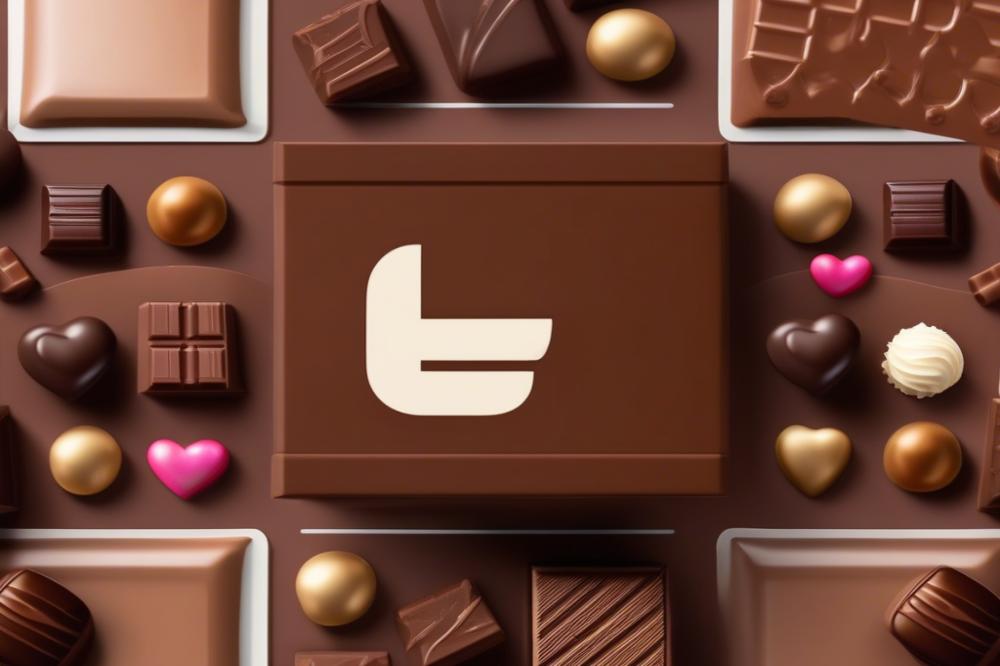The Influence of social media on chocolate branding
The chocolate industry continues to evolve in fascinating ways. Recent trends show an increasing demand for artisanal and ethically sourced products. Consumers are looking for quality, not just quantity. Innovations such as sustainable packaging and dark chocolate variants are gaining popularity. These shifts reflect a broader movement towards mindful consumption.
Branding strategies have adapted to these market changes. In particular, digital marketing has become essential. Companies must develop strong online presences to keep up with competitors. Engaging consumers on various platforms is now critical for success. Brand awareness relies heavily on how well businesses can connect with potential buyers. Crafting a compelling narrative about products enhances consumer engagement.
social media has played a pivotal role in shaping these branding approaches. Influencer marketing, for example, has emerged as a powerful tool. Brands now collaborate with social media stars to reach new audiences. They utilize content creation to promote their chocolates in a visually appealing manner. Audience targeting allows them to hone in on specific groups, maximizing their impact.
Understanding the influence of these platforms on consumer behavior is fundamental. Preferences can shift rapidly due to viral trends. People are swayed by what they see online, making it important for brands to stay current. Companies that adapt their marketing strategies to include social media insights are more likely to succeed. Ultimately, keeping up with branding trends in this fast-paced environment is crucial for staying relevant.
Understanding Social Media in chocolate branding

In recent years, online platforms have transformed the way brands market their products. Social media has become a vital part of digital marketing. It serves as a bridge between chocolate makers and consumers. Engaging with customers through these channels creates a direct line of communication. This interaction builds a community around brands, fostering loyalty and excitement.
Key Platforms in the Chocolate Industry
Multiple platforms cater to different audiences. Instagram stands out due to its visual nature, making it ideal for showcasing delicious chocolate creations. Facebook provides a wider demographic reach, suitable for sharing news, events, and promotions. Twitter allows brands to engage in real-time conversations and share quick updates. TikTok has emerged recently, offering an opportunity for creative content that can go viral. Brands can effectively connect with various segments of the audience by tailoring their content for each platform.
Facilitating Brand Awareness and consumer engagement
Effective marketing strategies harness the power of social media for brand awareness. Eye-catching images and engaging stories can captivate potential customers. Influencer marketing plays a crucial role in this process. Collaborating with trusted figures helps brands reach a larger audience and builds credibility. Consumers are more likely to try a brand when it’s recommended by someone they admire.
Content creation is another essential aspect of branding trends in the chocolate sector. Brands can share recipes, behind-the-scenes production stories, and promotional offers. This kind of content not only attracts attention but also encourages sharing among users. Such engagement creates a feeling of personal connection with the brand.
Audience targeting improves marketing efforts as brands analyze their followers’ behavior. Knowing what resonates with consumers helps chocolate brands fine-tune their messaging. This understanding drives better engagement and ultimately boosts sales. Regular interaction with followers can build a strong community around a brand, turning casual buyers into loyal fans.
Digital Marketing Strategies in the Chocolate Industry

The chocolate industry has evolved significantly in the age of technology. Digital marketing has become essential for brands looking to connect with consumers. Effective strategies in this field often focus on building brand awareness and fostering consumer engagement.
One core element is the integration of various platforms into a cohesive marketing plan. This strategy allows brands to craft a consistent message across their online presence. As a result, organizations can reach their target audience more efficiently. Utilizing specific marketing strategies can help chocolate brands stand out amidst fierce competition.
Content Creation
Content creation plays a vital role in attracting consumers. Engaging posts, videos, and stories capture the essence of chocolate and its enjoyment. By sharing behind-the-scenes looks, brands create a connection that resonates with audiences. This humanizes the product and makes it more relatable. Creative storytelling can elevate a brand’s image and drive interest.
Influencer Marketing
Meanwhile, influencer marketing has emerged as a powerful tool. Brands collaborate with social media personalities who align with their values. These influencers showcase chocolate products to their followers, generating buzz and excitement. Their endorsements can lead to peak interest and increased sales. Furthermore, this approach allows brands to tap into specific communities within the chocolate industry.
Case Studies of Successful Brands
Various chocolate brands have effectively harnessed digital marketing strategies. Take the example of a well-known organic chocolate maker. They created a series of engaging videos highlighting local farmers. By showcasing ethical sourcing, they bolstered their brand’s story, attracting customers who value sustainability.
Another instance involves a brand that frequently runs giveaways through social media. This strategy boosts their visibility while encouraging participation from users. People love to share their favorite chocolate moments, and this brand made it easy to join in. Their emphasis on community engagement has significantly enhanced their brand identity.
Lastly, a premium brand focused on striking visuals aligned with branding trends. They used high-quality images and minimalist designs to appeal to a luxury market. Through this method, they successfully garnered a dedicated following. Their online campaigns often feature seasonal specials, attracting loyal customers throughout the year.
The utilization of digital marketing strategies in the chocolate industry is changing the way brands connect with consumers. Emerging trends within this space guarantee that competition remains fierce. Staying innovative and authentic will help brands thrive in today’s digital landscape.
Influencer Marketing and Its Impact

Influencer marketing is a vital part of digital marketing, especially in the chocolate industry. This strategy uses popular figures on platforms like Instagram or TikTok to promote products. These influencers have a loyal following that trusts their opinions. Thus, they play a critical role in shaping consumers’ perceptions of chocolate brands.
Many chocolate brands collaborate with influencers for various campaigns. For instance, a well-known chocolatier might partner with a food blogger for a recipe video featuring their products. Another example is a lifestyle influencer showcasing a gourmet chocolate box as a perfect gift. Each of these collaborations brings a fresh approach to content creation, appealing to different target audiences.
Measuring the success of influencer marketing campaigns involves several techniques. Brands often look at engagement metrics, such as likes and shares, to assess the impact. Furthermore, tracking website traffic can indicate how effective an influencer was in driving consumers to a brand’s online presence. Surveys or polls can also provide insights into brand awareness among followers after a campaign.
Overall, the relationship between chocolate branding and influencers is complex. As branding trends continue to shift, companies must adapt their marketing strategies to maintain consumer engagement. This dynamic landscape requires brands to keep innovating in their partnerships while aligning with the values of their audience.
Audience Targeting and Consumer Engagement
Techniques for Audience Targeting via Social Media
Digital marketing tools have changed how brands connect with consumers. Chocolate brands utilize various techniques to reach their audience effectively. Demographic data plays a crucial role in shaping marketing strategies. Brands analyze age, gender, and location to tailor messages that resonate. Another effective method is interest-based targeting. By identifying hobbies and preferences, companies make their ads feel more personal. Using analytics helps brands track engagement rates, facilitating timely changes to their approaches. Through these methods, chocolate companies can craft messages that attract the right consumers.
Examples of Interactive Content and Campaigns by Chocolate Brands
Interactive content captures attention like nothing else. Polls and quizzes engage consumers by inviting them to participate. Brands like Cadbury have launched campaigns where users vote for new flavors. These participatory experiences not only promote excitement but also enhance brand loyalty. Another example is Instagram challenges, where fans share their own chocolate recipes. Such campaigns build communities around shared interests. Engaging videos showing the chocolate-making process also draw interest. Brands utilize behind-the-scenes footage to humanize their products and foster deeper connections.
The Importance of Engaging Consumers to Foster Brand Loyalty
Engagement goes beyond likes and shares; it builds relationships. Consumers often feel a sense of belonging when brands include them in conversations. Connecting emotionally can significantly impact brand awareness. This connection translates into loyalty and repeat purchases. Brands that actively respond to customer comments build trust and encourage dialogue. Influencer marketing also adds another layer to consumer engagement. Influencers create authentic connections, making their endorsements feel more genuine. As marketing trends evolve, fostering these relationships becomes essential for sustained success. In the chocolate industry, where competition is fierce, nurturing ties with consumers is vital for long-term growth.
Content Creation Trends in Chocolate Branding
Insights into Effective Content Creation for Chocolate Brands
Creating content can be a game-changer for chocolate brands. Engaging and relatable material helps to foster consumer engagement. Marketers now focus on telling stories that resonate with audiences. The chocolate industry benefits when brands connect emotionally with consumers. Original concepts and visuals attract attention in a crowded market. Recognizing targeted demographics is crucial for reaching potential buyers. Digital marketing strategies need to align with what the audience cares about.
The Role of Visual Storytelling in Promoting Chocolate Products
Visual storytelling holds significant power in branding trends. High-quality photos and videos showcase the allure of chocolate. These visuals can transport viewers into a world of confectionery delight. Many brands use mouth-watering images to entice their followers. This approach enhances brand awareness and interest. Chocolatiers can create a narrative around their products. Using mood and aesthetics strengthens the connection between the consumer and the brand. Strong visuals can evoke emotions, encouraging people to share with friends online.
The Impact of User-Generated Content on Brand Perception
User-generated content is becoming increasingly important for chocolate branding. When consumers share their experiences, it builds trust in the brand. This form of marketing showcases authentic opinions. Influencer marketing adds another layer of credibility. Many brands encourage fans to post their own chocolate moments, fostering community. Such user engagement helps chocolate brands appear genuine. Positive reviews and shared photos enhance reputation. Chocolates that enjoy consumer participation often stand out in the marketplace.
Future Trends in Social Media and Chocolate Branding
Digital marketing continues to evolve, shaping how brands connect with consumers. Recently, video platforms have gained popularity. These platforms provide chocolate brands with a new way to showcase products. Short, engaging clips can grab attention and promote brand awareness. Brands can appeal to emotions using visual storytelling.
Influencer marketing is on the rise. More consumers turn to social media influencers for recommendations on food choices, including chocolate. This trend offers brands a chance to reach niche markets. Partnering with popular creators can create buzz around new flavors or seasonal collections. Authenticity is key; engaging influencers who share the same values as the brand resonates better with their followers.
Consumer engagement is shifting too. Today’s audience seeks more than just a product; they want experiences. Brands need to be interactive. Campaigns that invite consumers to share their chocolate moments can foster a sense of community. Encouraging user-generated content will likely become essential for growing connection.
Branding trends suggest a focus on sustainability and health. Consumers are becoming more conscious of their choices. Chocolate brands that highlight eco-friendly practices and transparent sourcing may attract a loyal customer base. Marketing strategies should reflect these values to align with consumer interests.
Expect to see increased attention to personalized marketing. Tailoring content to different audience segments makes the message stronger. Data analytics will play a significant role in audience targeting. Understanding preferences will help brands create engaging, relevant content, improving overall effectiveness.
The changing landscape of social media necessitates adaptability. Brands must be prepared to update strategies as platforms evolve. Keeping an active and vibrant online presence is crucial. Chocolate companies that accept change and innovate will thrive in the competitive market.
Final Thoughts on Chocolate Branding
In summary, the impact of social platforms on chocolate branding has been profound. Brands no longer only rely on traditional advertising; they now engage customers in interactive and creative ways. This shift enables chocolate companies to connect with their audience on a personal level. By sharing stories, recipes, and behind-the-scenes content, brands can foster a community around their products.
The need for a strong presence in digital marketing is clear. Consumers want genuine interactions and immediate responses. This expectation drives brands to be more transparent and attentive. Engaging with customers online is a vital strategy for maintaining loyalty. Regular updates, promotions, and visual content keep brands in the minds of potential buyers.
Looking to the future, chocolate branding will continue to evolve alongside technology and changing consumer behaviors. As the world shifts further into the digital age, brands must adapt to stay relevant. Innovative strategies that encourage consumer engagement will likely lead the way. Brands which can balance creativity and relatability will thrive. By harnessing these tools effectively, chocolate brands can not only capture attention but also build lasting relationships with chocolate lovers everywhere.



